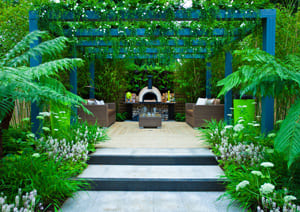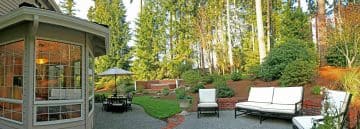
We all have some sense of what cohesion in a garden design means. It’s about creating a design where all of the elements work together, so that the garden is a single whole rather than a disjointed selection of elements. The garden should also be in harmony with the surrounding landscape and the house to which it belongs. Cohesion can be achieved in many ways, for example, by limiting the number of hard landscaping materials used, by repetition of hard and soft landscaping elements or by repetition of shapes. Harmony with the landscape may be achieved by repetition of materials or plants that appear in the wider landscape or by connecting the garden and landscape in some other way. In some designs, the landscape may be incorporated into the garden design, as in the concept of Shakkei, or ‘borrowed landscape’. The garden design is in harmony in the house when the two seem to belong together – this may be due to a repetition of colours, materials or shapes, for example, or to a shared period style.
Many students find that while they have an instinctive understanding of what cohesion is, it can be more difficult to come up with a definition in the exam. So how should cohesion be described in an exam answer? When discussing a 2013 exam question (‘Define the term cohesion in relation to garden design’), the examiners explain: ‘Most candidates were able to define cohesion but the best candidates provided appropriate examples. Suitable examples included: achieving harmony with the house and its geographical area in terms of hard landscaping materials, using features on the house to inform garden design and restricting hard/soft hard landscaping to avoid too much variety of materials. Overall cohesion is achieving something which “works” in the situation.’
Is there a difference between ‘Cohesion’ and ‘Unity’?

We are also often asked how to distinguish between ‘cohesion’ and ‘unity’, which seemed to be listed as separate features in older versions of the RHS Level 2 syllabus (now listed as ‘cohesion/unity’). In fact, the RHS do treat cohesion and unity as the same thing – in the 2015 June exam paper for R2111 they asked the question: ‘Define cohesion (unity) as a principle of garden design’. In the examiner’s comments they said: ‘Candidates who were able to define “cohesion” as creating a one-ness, by creating a garden which is in harmony with its surroundings, where elements relate to the house and where materials, plants etc. relate to each other to create a consistency throughout were awarded the mark.’
Helen
